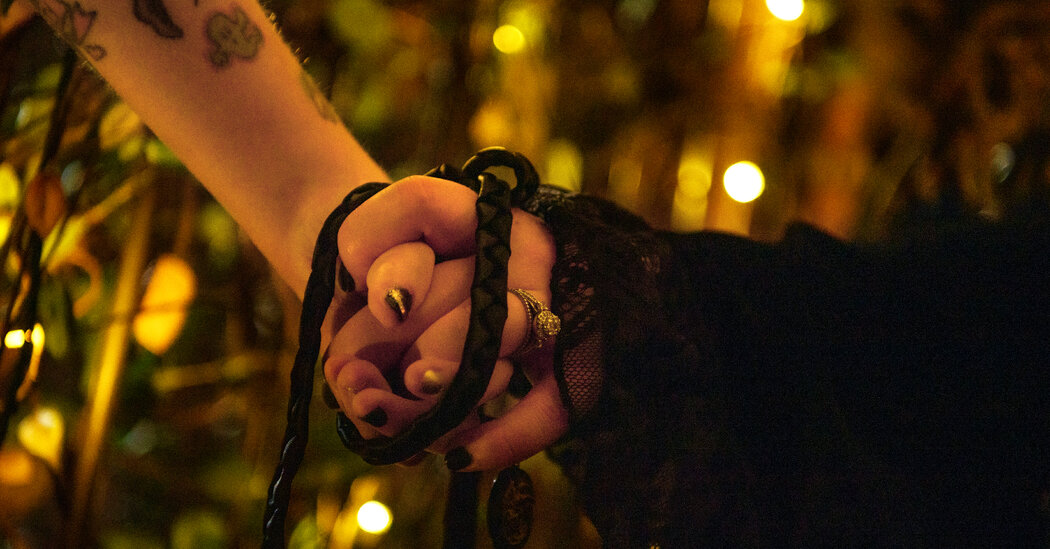
In October 2019, just over a year and a half after meeting on Tinder, Amber Fontenot proposed to Ashley McFaul in a corn maze. But it wasn’t legal marriage she was proposing — Ms. Fontenot already had a husband of nine years, Chad Fontenot.
Ms. Fontenot, who is polyamorous, was proposing that she and Ms. McFaul commit to each other with a Celtic handfasting ceremony.
Handfasting is an ancient practice that “has become more popular across the board,” said Scarlett Mullikin, an officiant based in Kankakee County, Ill., and the founder of Natural Element Ceremonies. And because it involves binding partners’ hands together — symbolizing the binding of two, three, four (or more) lives — it’s “the easiest way to connect multi-partners” or those who are polyamorous, she said.
Consensual non-monogamy (or C.N.M.) — an umbrella term that includes polyamory and open relationships — has helped to shed some of its stigma and practice of C.N.M. is more common than one might think said Ty David Lerman, a counselor-supervisor and sex therapist in Houston. A 2021 study found that 1 out of 6 of the individuals surveyed had a desire to engage in polyamory while 1 in 9 have done so at some point in their lives.
Interest in open relationships appears to be even higher, according to a 2021 YouGov poll: It found that 25 percent of the more than 25,000 individuals surveyed were interested in an open relationship. (An open relationship often entails having other sexual partners, while polyamory, which means “many loves,” refers to one having other romantic partners.)
“I wanted Ashley to know I love her as much as I love Chad,” said Ms. Fontenot, a territory manager for a hydraulic hose manufacturer. Which is not to say that Chad and Ashley are involved with each other: “Ashley is monogamous,” Ms. Fontenot said. They all live together in Houston.
Ms. McFaul, 34, and Ms. Fontenot, 30, were committed on Oct. 31 in a handfasting ceremony led by Ms. McFaul’s aunt, Cindae Wilson, before 35 guests. Mr. Fontenot was one of them. “Chad is very supportive of us and loves us,” Ms. Fontenot said.
“It was important to have a moment in time to share our love and celebrate it with the people that were important to us,” Ms. McFaul said. “It’s about a basic level of human respect and love and nothing else.” (Ms. Fontenot and Ms. McFaul are also featured in an upcoming episode of “Say Yes to the Dress” shot in New York City at Kleinfeld’s.)
Handfastings “have been used as a marriage ceremony or included in marriages since ancient Norse times,” Mr. Lerman said, adding that they provide “the origin of the colloquial term, ‘tying the knot.’”
The ceremony can involve a variety of cords or ribbons in different colors and materials, said Lori Prashker-Thomas, the founder of Ceremonies by Lori based in Wilkes-Barre, Pa. Historically speaking, “in many instances, rings were only for the very rich, while love knows no such bound,” she added. “The cords are not permanent but perishable, as a reminder that all things of the material eventually return to the earth, unlike the bond and the connection that is love, which is eternal.”
There is certain verbiage that is avoided when commitment ceremonies are performed in order to not misrepresent the event as a legal wedding. For example, Ms. Mullikin said, she avoids the words “marriage,” “married,” “husband,” “wife,” “spouse” and “wedding” and instead uses terms like “commitment,” “bond,” “union” and “partners.”
And at the end of the day, of course, the benefits of a committed relationship are the same whether monogamous, polyamorous, legally recognized or not. “There’s a safety and a security to crossing this threshold of marriage,” Mr. Lerman said. “Polyam relationships are still just relationships.”
And with a handfasting ceremony, Ms. Mullikin said, partners can “experience the joy and the energy and the bliss that goes into a wedding day.”
Nonlegal ceremonies are, of course, easier to dissolve than legal ones; however, the fact that they are nonlegal also allows for more inclusion. Ms. McFaul, a disability activist, artist and content creator, has arthrogryposis, a condition that “affects my arms and upper body, and my elbows are locked straight,” she said. Getting legally married would likely — and greatly — adversely affect the social security and disability benefits she receives, she said.
But if it’s legal protection a partner seeks, sometimes an officiant may perform a legal marriage between two partners and a handfasting among all of the partners.
Then, if protection for the nonlegal partners is desired, “there are legal steps one can take to ensure these things are in place, such as including all partners in your will, assigning joint power of attorneys, and other legal documents,” Mr. Lerman said, adding that each state has its own “unique hoops to jump through,” so it’s best to consult with a local lawyer.
Additionally, groups like the Polyamory Legal Advocacy Coalition and the Harvard Law School LGBTQ+ Advocacy Clinic are working to protect the rights of those in non-monogamous relationships.
Paperwork can address the legal connections. But for those in search of less worldly connections, “You have to put yourself out there and you have to love,” Ms. Fontenot said. “Otherwise, what’s the point of any of it?”






